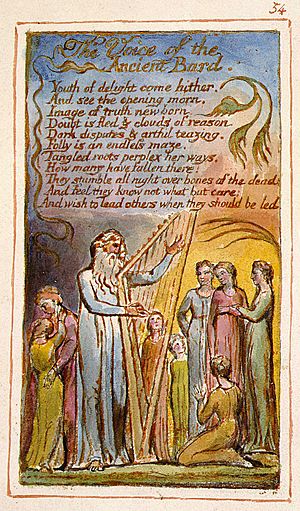The Voice of the Ancient Bard facts for kids

The Voice of the Ancient Bard is a short poem written by the famous English poet William Blake. It was first published in 1789 as part of his book Songs of Innocence. Later, Blake moved it to Songs of Experience, which was the second part of a bigger collection called Songs of Innocence and of Experience (published in 1794). This poem shares a message about wisdom and how people can sometimes get lost.
The Poem's Words
Here is the poem exactly as William Blake wrote it:
Youth of delight come hither.
And see the opening morn,
Image of truth new born.
Doubt is fled & clouds of reason
Dark disputes & artful teazing.
Folly is an endless maze,
Tangled roots perplex her ways.
How many have fallen there!
They stumble all night over bones of the dead
And feel they know not what but care;
And wish to lead others when they should be led.
The poem talks about young people and invites them to see a new beginning, like the morning. It suggests that doubt and confusing arguments disappear. It warns that "folly" (meaning foolishness or mistakes) is like a maze where people get lost. Many have stumbled there, feeling confused and trying to guide others when they themselves need guidance.
Gallery of Original Pages
This gallery shows different versions of the poem's page from Blake's original printed books. Each copy was unique because Blake printed and colored them by hand.
-
From Songs of Innocence, copy B, 1789, at the Library of Congress.
-
From Songs of Innocence, copy G, 1789, at the Yale Center for British Art.
-
From Songs of Innocence and of Experience, copy C, 1789, 1794, at the Library of Congress.
-
From Songs of Innocence and of Experience, copy L, 1795, at the Yale Center for British Art.
-
From Songs of Innocence and of Experience, copy Y, 1825, at the Metropolitan Museum of Art.
-
From Songs of Innocence and of Experience, copy Z, 1826, at the Library of Congress.
-
From Songs of Innocence and of Experience, copy AA, 1826, at The Fitzwilliam Museum.
Musical Versions
Many composers have been inspired by "The Voice of the Ancient Bard." They have created different musical pieces using Blake's poem as the lyrics.
- John Harbison (born 1938, USA): He wrote "The Voice of the Ancient Bard" in 1971. It is part of his Five Songs of Experience for singers and instruments.
- Gary Higginson (born 1952, UK): His version of the poem was created in 1981-1982. It is for a choir (SATB means Soprano, Alto, Tenor, Bass voices).
- Chester Edward Ide (1878–1944, USA): He set the poem to music in 1928. It was for two young voices singing without instruments (a cappella).
- Joan Anne Littlejohn (born 1937, UK): Her musical setting for voice and piano was made between 1967 and 1970.
- Leo Smith (1881–1952, Canada): He composed a version for voice and piano around 1900.
- Tod Machover (born 1953, USA): This poem is featured in his opera Skellig, which premiered in 2008.









